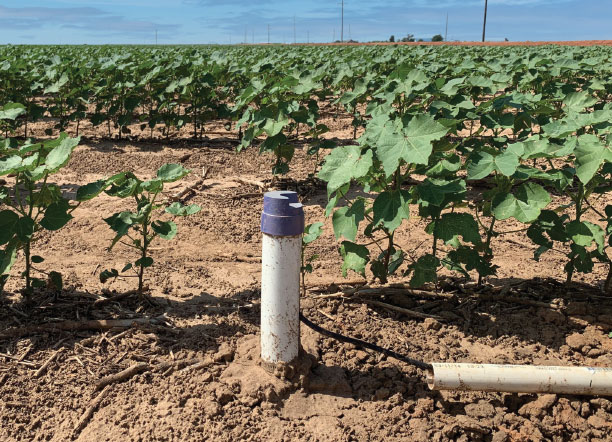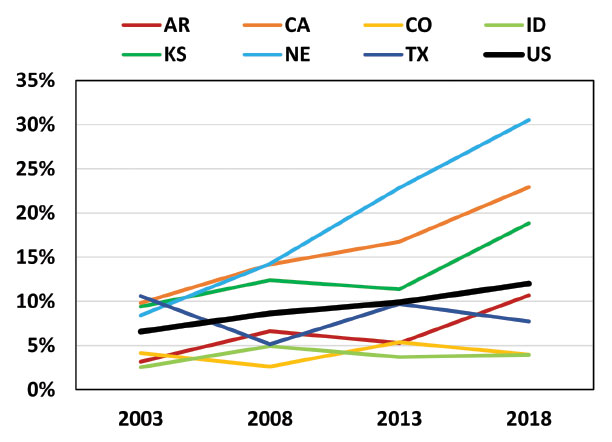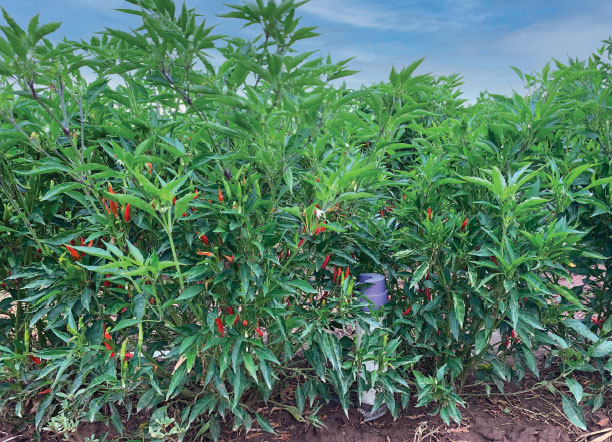
When properly used, soil moisture sensors provide valuable data to improve irrigation efficiency, save water and improve yields. However, adoption of this technology has been slow over the years. A 2013 study conducted by the U.S. Department of Agriculture revealed that only 10% of irrigated farms in the United States used soil moisture data. A new survey conducted in 2018 showed that the utilization of soil moisture sensors in making irrigation decisions increased to 12%. Nebraska was the leading state with 31% of the farms using soil moisture technology, followed by Mississippi (27%) and California (23%).
Although a few states have experienced increased adoption during previous years, the fairly slow expansion at the national level and no change for many states (as well as some declines) suggest that transfer of this technology is still facing barriers. When considering the use of soil moisture sensors to improve financial and environmental sustainability of irrigated agriculture, three main stakeholders can be considered: sensor manufacturers, growers and policymakers. There are several opportunities for each of these stakeholder groups to play a part in increasing utilization of soil moisture sensors in irrigation scheduling.


Sensor manufacturers have made advancements to improve sensor accuracy and reduce installation and maintenance costs and efforts. For example, several manufacturers have designed sensors and probes that can be hammered or screwed into the soil. This reduces installation time and the need for prior experience. Another manufacturer has developed a tapered probe that, while still requiring to drill a hole, does not require the use of slurry, as the tapered design ensures a snug fit. Although these advancements are exciting, further modifications in sensor design to achieve good sensor-soil contact with less time and experience could increase users’ willingness to consider this technology.
Another opportunity for manufacturers is to improve the power requirement and wireless data transfer of soil moisture sensors. More efficient batteries reduce or eliminate the need to replace batteries frequently or to add solar panels to recharge batteries. More compact and less rigid antennae for data transmission would also be helpful since both solar panels and antennae present challenges for movement of agricultural machinery across the field. Having to change the path or adjust the equipment just to go over a solar panel or antenna adds to the time and cost of the intended operation and negatively impacts sensor desirability.
Sensor manufacturers have made advancements to improve sensor accuracy and reduce installation and maintenance costs and efforts.

The third opportunity for sensor manufacturers is to offer and/or better their decision support tools. Many sensors provide estimates of soil water content, temperature and apparent electrical conductivity at several soil layers and frequent time intervals. This means the users receive hundreds of data points every day. Presenting this large database in an easy-to-understand format and providing additional tools to turn data into decisions could boost sensor applications in irrigation scheduling. Using consistent terminology and graphics among manufacturers can also reduce confusion and the time required to learn about outputs of a new sensor.
For growers, one opportunity is to consider all benefits of implementing soil moisture sensors. Like any other technology, the return on investment should be reasonable and justified for soil moisture sensors to be purchased and used in irrigation management. In some cases, however, only the obvious benefits of sensors are considered when evaluating ROI. These more obvious benefits are avoiding over-irrigation and thus conserving water resources and reducing energy costs associated with extracting, conveying and applying water. In our field evaluations across Oklahoma we have encountered fields that were consistently under-irrigated even though water availability was not an issue. Use of soil moisture sensors can help avoid yield losses due to under-irrigation.

We have also observed fields that receive small, frequent irrigations, which leads to a larger portion of applied water evaporating from soil and crop surfaces and thus not being available in the deeper soil layers to be extracted by roots later. This practice can also result in shallow root systems that cannot extract water (and nutrients) from deeper layers. In other areas where irrigation capacity is limited due to natural reasons or consumption caps, sensors can help optimize deficit irrigation management to minimize yield losses. For example, sensor readings can be used to cut back on irrigation during less sensitive growth stages to preserve limited irrigation water for more sensitive growth stages. The value proposition of soil moisture sensors is far beyond their role in avoiding over-irrigation. They can be used to control and manage water fluxes in a fashion that would maximize water and nutrient uptake efficiency and, consequently, farm profitability — especially when water is short.
The value proposition of soil moisture sensors is far beyond their role in avoiding over-irrigation.

The second opportunity for growers is to test existing and new sensors and provide feedback to sensor manufacturers, researchers and extension specialists on the positive and negative aspects of the new sensors. This requires time and resources on the part of growers and provides no immediate benefits to them, but it is crucial in addressing the shortcomings of sensors and brainstorming solutions to improve this technology. Without direct input from intended users of the technology, it is difficult (if not impossible) to identify and fix issues.
Finally, the opportunities for policymakers at local, state and federal levels are to support applied research and extension projects by universities to facilitate testing and demonstrating the use of sensors. With a considerable number of new sensors or models being introduced to the market each year, there is a need to assess the accuracy, reliability and user-friendliness of these sensors at research stations or commercial farms in collaboration with partnering growers. Once the sensors are tested and verified, supportive policies and financial incentives can help increase their adoption by reducing the financial risk of investing in these technologies. The incentives offered to growers should be widely available and commensurate with the costs of sensors and accessories.
8280 Willow Oaks Corporate Drive | Suite 630 | Fairfax, VA 22031
Tel: 703.536.7080 | Fax: 703.536.7019
HOME | ABOUT US | ADVERTISE | SUBSCRIBE | CONTACT | PRIVACY POLICY | IA ANTITRUST STATEMENT